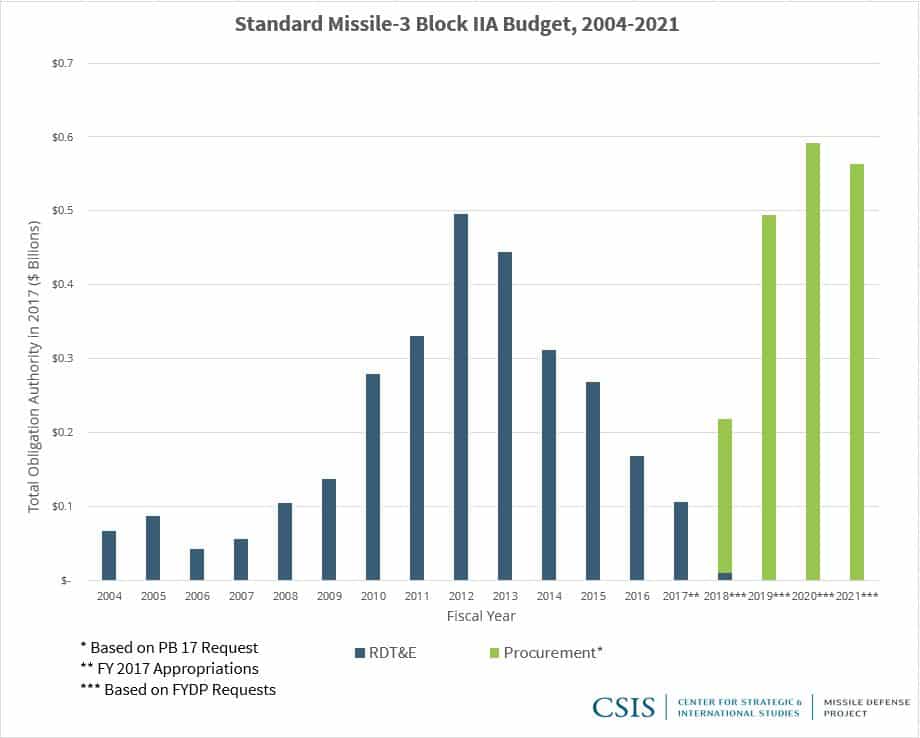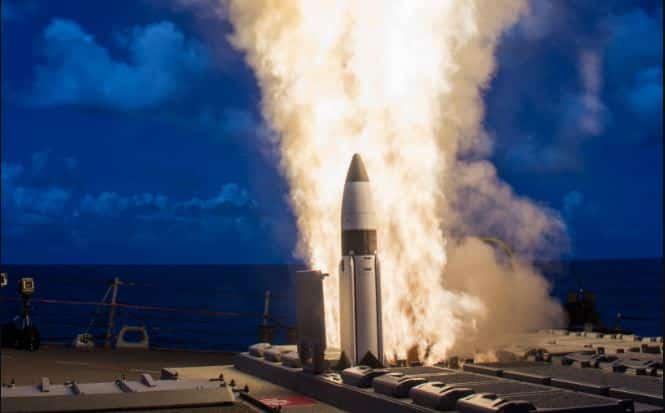The Missile Defense Agency yesterday conducted an intercept test of the Standard Missile-3 Block IIA (SM-3 IIA), a relatively new interceptor designed for use in the Aegis Ballistic Missile Defense (BMD) program. Something appears to have gone wrong, however, and the interceptor did not destroy its target. The type or cause of failure is not yet known, nor will it likely be known for some time. The June 21 test was the fourth flight test and the second intercept attempt of the SM-3 IIA configuration. The previous intercept test in February 2017, by contrast, had been successful in intercepting a medium-range ballistic missile target.
What is Aegis BMD?
Aegis BMD represents the sea-based component of the Ballistic Missile Defense System. The U.S. Navy currently deploys Aegis BMD on 28 of its Arleigh Burke-class destroyers and 5 of its Ticonderoga-class cruisers. In 2016, the United States activated Aegis BMD capability at a land-based Aegis Ashore site in Devesulu, Romania. A second Aegis Ashore site is under construction in Poland and is scheduled to be completed in 2018.
Like all air and missile defense systems, Aegis includes a mix of interceptors, sensors, and command and control. The primary sensor for the missile defense mission is the SPY-1D radar, an S-band radar housed on the deckhouse. This radar is colocated with the interceptors, meaning that it can support updates to the interceptor within line-of-sight. Some past testing has included longer-range intercept by passing information to Aegis interceptors from external sensors like ground-based TPY-2 radars and space-based Space Tracking and Surveillance System (STSS) satellites. These “launch on remote” and “engage on remote” capabilities hold considerable promise to improve the defended area of the system, but they are still being implemented. Besides Aegis, other U.S. missile defense systems include Patriot, Terminal High Altitude Area Defense (THAAD), and Ground-based Midcourse Defense.
What is the Standard Missile-3 Block IIA?
Yesterday’s test involved the Standard Missile-3 Block IIA, the latest block version of the Standard Missile family of air and missile defense interceptors. Unlike previous missiles, however, the SM-3 IIA is the product of a codevelopment effort with Japan, which also operates the Aegis Weapons System and could potentially deploy Aegis Ashore to protect its territory in the coming years. The SM-3 family of interceptors have kill vehicles that collide with a threat missile or warhead during its midcourse phase, outside the atmosphere. These hit-to-kill interceptors destroy their targets with kinetic energy rather than with high explosive or blast fragmentation.
The hit-to-kill approach to intercept is shared with the SM-3 IA and IB, but it contrasts with the SM-2 Block IV and SM-6 missiles, which use a blast fragmentation warhead and defeat their targets within the atmosphere, which for ballistic missiles means their terminal phase. The SM-3 IIA improves on earlier interceptors with a more powerful motor, accomplished by widening the body of the missile to a uniform 21-inch diameter, virtually the maximum diameter that will fit within the Mk 41 Vertical Launching System (VLS). The larger fuel mass of the solid motor translates to greater velocity, which in turn means a larger defended area. By contrast, the IA and IB have a 21-inch first stage but are only 13.5 inches in diameter across the rest of their length. The SM-3 IIA also incorporates a new more sensitive seeker, increased divert capability, and a longer operating time for its upgraded kill vehicle (to accommodate a longer range and duration in space). Although significantly smaller than the Ground-based Interceptors (GBIs), SM-3 IIAs have begun to blur the distinction between homeland and regional defense. Although not yet tested against an intercontinental ballistic missile (ICBM) or intermediate-range ballistic missile (IRBM), Missile Defense Agency director VADM James Syring recently testified that “there is inherent capability in the SM-3 IIA to engage longer-range threats,” adding they could potentially “add another layer of defense” for particular areas such as Hawaii. For now, however, GBIs are the only system exclusively devoted to homeland missile defense.

What is the importance of the cooperation with Japan?
The long-running codevelopment of the SM-3 IIA represents an important part of U.S.-Japan defense cooperation and a significant example of multinational missile defense efforts broadly. The arrangement offers a potential model for how the United States might work with other allies and partners to share both costs and the technological fruits of such endeavors. Both Japan and the United States are likely to procure the SM-3 IIA for their respective navies, which could produce economies of scale and potentially advance other spinoff programs.
The interceptor will have a global presence once it becomes operational. Besides the Aegis ships (or deployment ashore) for the United States and Japan, a mix of the IIA and other SMs are intended to be deployed at the two European Aegis Ashore sites, for the defense of NATO.
What is the significance of this particular test?
The test record of the Aegis program and hit-to-kill intercept within the SM family broadly now stands at 35 successful intercepts out of 43 attempts against ballistic missile targets. The June 21 failed test was the fourth flight test of the IIA and the second intercept attempt with that missile to date.
The causes of this failure are not yet known and will likely not be known for some time until the data from the event can be fully analyzed. The failure could have been due to numerous causes, whether from the ship, from or between stages of the motor, or from something more directly related to the kill vehicle. The previous intercept test in February 2017 had been successful.
Depending on the results and how the inquiry into yesterday’s test proceeds, it could presumably affect the schedule for delivery of the first IIA in 2018, as well as the operational deployment on U.S. Navy ships and at Aegis Ashore sites in Europe.
What’s next for SM-3 development?
The next step will be to ascertain what went wrong in the test, beginning with whether it was an issue with the motor, the Aegis weapons system, the kill vehicle, or some combination of those. The results of all that will naturally inform the evolution of the SM family. There are currently no formal plans for continued incremental or block evolution of the SM-3 interceptor beyond the IIA, but the forthcoming missile defense policy review may reconsider this option. Continued evolution of interceptors will be important to allow the United States to continue to outpace the increasingly complex ballistic missile threats that it faces.
Additional potential enhancements might include new seeker and divert systems, a still larger and more energetic motor, throttleable solid motors, or the addition of a more aerodynamic kill vehicle. Removing the current exoatmospheric kill vehicle and combining the full 21-inch motor on the IIA with a different kind of payload could potentially be used for threats within the high atmosphere, as does THAAD and the SM-6. Endoatmospheric capability would be important for defeating hypersonic boost glide vehicles skimming along the upper reaches of the atmosphere.
The Obama administration’s European Phased Adaptive Approach previously included a further upgrade to the Standard Missile family, the SM-3 Block IIB. This missile was intended to be able to intercept a future Iranian ICBM during its boost or ascent phase, providing some defense of U.S. territory from forward-based locations in Europe. The state of the associated technology and the desirability of such a capability could well be revisited in the Pentagon’s 2017 missile defense review.
In recent years, the Department of Defense has unveiled other antiair missiles being repurposed for multimission flexibility, including the SM-6 and ESSM. The larger and more energetic motor stack of the SM-3 IIA could also be paired with an entirely different kind of warhead for other missions, such as antiship or land attack capabilities.
